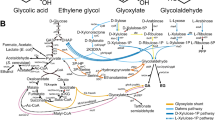Abstract
Methylobacterium rhodesianum and Ralstonia eutropha were cultivated to produce polyhydroxybutyrate (PHB) using media which contained glycerol and casein hydrolysates as C/N-substrates. In these media the pH had not to be regulated during the fermentations. The first strain accumulated an average of 39% PHB during 92 h of cultivation in flasks and 50% PHB during 45 h of cultivation in fermenters. The second one yielded an average of 47% PHB during 67 h of cultivation using casein peptone and 65% PHB during 45 h of cultivation using Casamino acids in the medium. Calculated N-balances showed that about 65% of the supplied nitrogen was used for growth of non-PHB cell dry mass. The conversion of glycerol to PHB was 17% (w/w).
Similar content being viewed by others
References
Ackermann JU, Müller S, Lösche A, Bley T, Babel W (1995) Methylobacterium rhodesianum cells tend to double the DNA content under growth limitations and accumulate PHB. J. Biotechnol. 39: 9–20.
Babel W, Brinkmann U, Müller RH (1993) The auxiliary substrate concept — an approach for overcoming limits in microbial performances. Acta Biotechnol. 13: 211–242.
Bormann EJ, Leissner M, Beer B (1997) Growth and formation of poly(hydroxybutyric acid) by Methylobacterium rhodesianum at methanol concentrations of above 25g/l. Acta Biotechnol. 17: 279–289.
Bormann EJ, Leissner M, Roth M, Beer B, Metzner K (1998) Production of polyhydroxybutyrate by Ralstonia eutropha from protein hydrolysates. Appl. Microbiol. Biotechnol. 50: 604–607.
Cland S (1996) Research of new outlets for glycerol — recent developments in France. In: H Eierdanz, ed. Perspektiven nachwachsender Rohstoffe in der Chemie. Weinheim: Verl. Chemie, pp. 137–149.
Green PN, Bousfield IJ, Hood D (1988) Three new Methylobacterium species: M. rhodesianum sp. nov., M. zatmanii sp. nov., and M. fusijawaense sp. nov. Int. J. Syst. Bacteriol. 38: 124–127.
Hänggi UJ (1995) Requirements of bacterial polyesters as future substitute for conventional plastics for consumers good. FEMS Microbiol. Rev. 16: 213–220.
Hauthal HG (1996) Nachwachsende Rohstoffe — Perspektiven für die Chemie. Nachr. Chem. Tech. Lab. 44: 32–35.
Lee SY (1996) Plastic bacteria? Progress and prospects for polyhydroxyalkanoate production in bacteria. Trends Biotechnol. 14: 431–438.
Lehmann O, Metzner K, Rauchstein KD, Berndt C, Christner A, Menzel KD, Bormann EJ (1996) Verfahren zur fermentativen Herstellung von Polyhydroxybuttersäure. DE 19630175.0.
Metzner K, Berendt C, Christner A, Hilliger, M, Geuther R, Perlet K, Roth M, Bormann EJ, Leißner M (1997) Mikrobielles Verfahren zur Herstellung von Polyhydroxyalkanoaten. DE 19704045.4
Roth H (1953) Bestimmung benachbarter Hydroxylgruppen. In: Müller E, ed. Methoden der organischen Chemie, Band II, Analytische Methoden. Stuttgart: Verlag Georg Thieme, pp. 360–363.
Taidi B, Anderson A, Dawes EA, Byrom D (1994) Effect of carbon sources and concentration1 on the molecular mass of poly(3-hydroxybutyrate) produced by Methylobacterium extorquens and Alcaligenes eutrophus. Appl. Microbiol. Biotechnol. 40: 786–790.
Williamson DH., Wilkinson JF (1958) The isolation and estimation of the poly-β-hydroxybutyrate inclusions of Bacillus species. J. Gen. Microbiol. 19: 198–209.
Yamane T (1993) Yield of poly-D(-)-3-hydroxybutyrate from various carbon sources: a theoretical study. Biotechnol. Bioengin. 41: 165–170.
Author information
Authors and Affiliations
Rights and permissions
About this article
Cite this article
Bormann, E., Roth, M. The production of polyhydroxybutyrate by Methylobacterium rhodesianum and Ralstonia eutropha in media containing glycerol and casein hydrolysates. Biotechnology Letters 21, 1059–1063 (1999). https://doi.org/10.1023/A:1005640712329
Issue Date:
DOI: https://doi.org/10.1023/A:1005640712329




